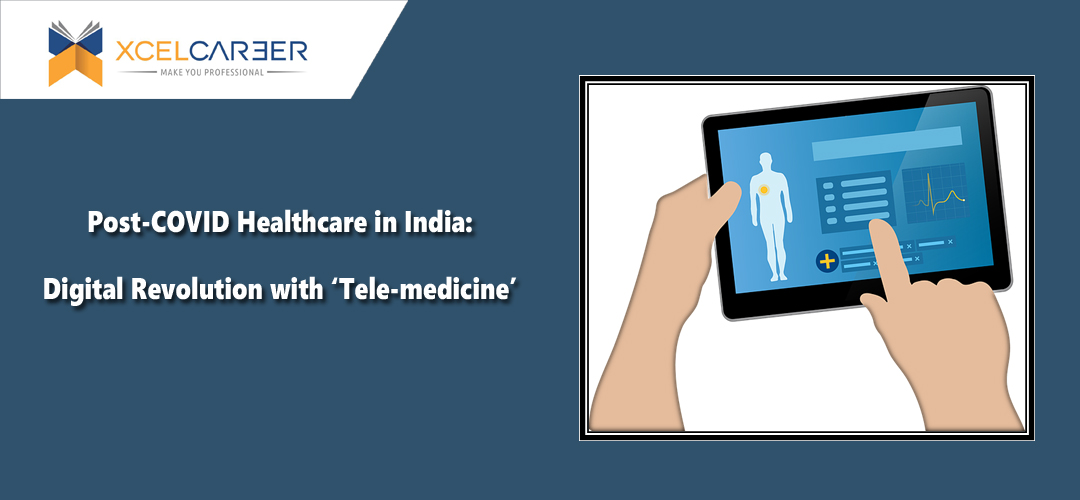India, despite being a developing country, has always been at par and at times ahead of many other nations in healthcare and technology. We may have been slow to adapt to changes but have witnessed major revolutions in history. Such changes are consistent and have made a great impact on the people of the country. Could anyone imagine life without the internet during “Lockdown” days? Currently, we are going through such a phase that may even be called a ‘digital revolution’.
The whole world trembled in the COVID-19 pandemic which started in 2019 and by now in 2021, we have almost learned to live with, by adapting to the disastrous situation. Our industries, including the healthcare sector faced major backlash during this period. But healthcare being an inevitable domain forged ahead through the platform of ‘telemedicine’.
What is Telemedicine?
Telemedicine is the practice of healthcare services through internet and telecommunications technologies. The concept of telemedicine is not new but was not very popular in India. We always used to soak in the satisfaction of consulting a doctor physically. Telemedicine practice first started in 1960’s by NASA’s Public Health Department, in the United States. During those days it was only popular in rural areas where specialist services were inaccessible.
Telemedicine was practiced only in few regions of India in the pre-covid period. Fears of COVID infection and spread during hospital visit have led to a sudden increase in the practice of telemedicine in the country.
Guidelines for Telemedicine Practice in India
Due to the Increase in telemedicine practice, the Ministry of Health and Family Welfare (MoHFW) along with the NITI (National Institution for Transforming India) Aayog Committee and Medical Council of India (MCI) have recently issued new guidelines for practicing telemedicine in India.
According to these guidelines:
- Only a registered medical practitioner is permitted to conduct the telemedicine consultation.
- Important exclusions included are that there is no provision of practice outside India and no practice of surgical or invasive procedure through the platform.
- Registered medical practitioners are mandated to attend an online training program before starting telemedicine practice.
- Medical practitioners are required to maintain documents related to consultations.
- In case of an emergency, in-person consultation should be given.
- The guidelines also included medicines that are not to be prescribed, a fee for consultation etc.
Digital Applications for Teleconsultations in India
Communication with a practitioner can be in the form of audio, video, text or the digital sharing of the data. There is a plethora of digital applications that support virtual consultations such as ‘Practo’,‘1mg’, ‘myUpchar’, ‘docprime’, ‘MFine’, etc. which provide:
- Teleconsultation,
- Online diagnostics, and
- Online pharmacy
According to India’s eHealth market opportunity report, 2021, eHealth in India is expected to reach 5.4 billion US dollars by 2025 and is peaking at a rate of 31%. Mobile applications such as ‘Practo’ and ‘myUpchar’, saw 4 times increase in the number of patients during the pandemic in comparison to the pre-covid duration.
What are the Advantages of Telemedicine?
Telemedicine practice has helped so many around the nation to get the right healthcare service during the lockdown period and proceed to be helpful for timely and effective management of chronic diseases such as asthma, hypertension, diabetes mellitus etc., as all these patients belong to the risk category and are more susceptible Covid-19 disease.
Telemedicine has multiple advantages compared to conventional healthcare consultations:
- By bringing healthcare to the fingertips, it helps common people save on transportation charges.
- It is more convenient.
- It helps those patients from rural areas, who do not have access to facilities.
- It helps those patients who have limited physical mobility. For example, the transport of a bed-ridden cancer patient to the hospital for consultation can be difficult. In such a case, the patient can have a consultation with the doctor virtually.
- Telemedicine has reduced a great amount of burden on hospitals and clinics and is thereby helping everyone maintain social distancing.
Drawbacks of Telemedicine
Telemedicine, on the other hand, obviously has some demerits too.
- The information given through telemedicine can be mis-interpreted leading to other problems.
- Privacy and data confidentiality are the main drawbacks of telemedicine. Patients and practitioners should strictly adhere to all privacy guidelines while practising telemedicine.
- There is also a need for high-speed internet and access to a computer or mobile phone to avail the service. This becomes difficult for a person who cannot afford these and also who is not educated enough to use these technologies.
- Telemedicine practice is also time-consuming as it requires time to set up the required infrastructure.
- The patient will never-the-less have to visit a hospital or clinic for a blood check-up or imaging.
There should be a proper reimbursement system to pay for the services provided through telemedicine. With the introduction of online payment platforms such as ‘Google Pay’, this area has seen many improvements and streamlining.
Conclusion
Telemedicine practice is undoubtedly essential for us now in order to progress from the pandemic situation. Telemedicine is slowly making progress in assisting patients with respiratory diseases also. Clinical research and trials are in progress for tele-monitoring of ventilator-dependent patients in several countries.
Telemedicine will help us get healthcare services on time whilst protecting us by avoiding unnecessary contacts during this prevailing pandemic. Tele-medicine, however cannot completely replace face to face consultation that we have at the hospital.
The government of India is educating people on the importance of this practice, to avoid congestions in the hospital. This is a huge improvement in the field of healthcare services and public health. The Healthcare sector in India is exploring more possibilities in digital health as they have witnessed a major transition from conventional healthcare practice to digital health ever since the beginning of this pandemic called COVID 19.

